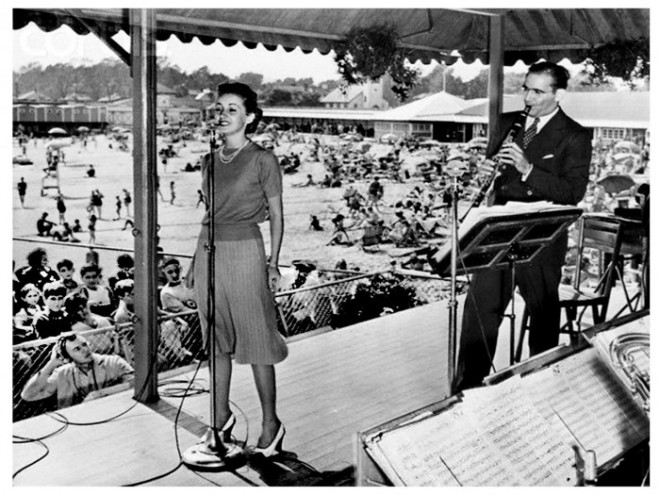Captain Glenn Miller (tb & director); Zeke Zarchy, Whitey Thomas, Bobby Nichols, Steve Steck, John Carisi, Jack Steele (tp); Jimmy Priddy, James Harwood, John Halliburton, Larry Hall, Nat Peck (tb); Addison Collins (Frhrn); Hank Freeman, Gabe Galinas, Fred Guerra (as); Jack Ferrier, Vinnie Carbone, Murray Wald, Peanuts Hucko, Lynn Allison (ts); Chuck Gentry, Mannie Thaler (bar); George Ockner (concertmaster of 20-piece string section); Mel Powell, Jack Russin (p); Carmen Mastren (g) Trigger Alpert, Joe Shulman (b); Ray McKinley, Frank Ippolito (d); Jerry Gray, Norman Leyden, Ralph Wilkinson, Bill Finegan (arr).
This is a composite personnel, from which the recording units were drawn.
V-Disc Session, RCA Victor Studios. New York, January 21, 1944
VP-563 Embraceable You (strings only) (RW arr) V-Disc 183
VP-563 G.I. Jive (RMcK & CC vcl, JG arr) V-Disc 183
VP-618 Moon Dreams (JD & CC vcl) V-Disc 201
VP-655 Stealin’ Apples (Fletcher Henderson arr) V-Disc 223
By the time of the third Glenn Miller AAF Band V-Disc recording session, the V-Disc program directors were making arrangements to acquire fresh material for their releases. In addition to reissuing older commercial records and producing their own sessions, they were now able to use performances from CBS and NBC radio broadcasts and rehearsals. This opened a vast library of material to choose from, and bands like Glenn’s did not need to record specifically for V-Disc, as their regular broadcasts provided quality music to select from. After this January date, a dozen later Miller V-Discs came from his radio shows, specifically the weekly I Sustain the Wings NBC series.
Two standards and two new songs make up the program. The strings have it all to themselves for the Gershwins’ lovely EMBRACEABLE YOU, with concertmaster George Ockner’s fiddle leading the way. Fourteen years earlier, Glenn was in the pit band of Girl Crazy, the Broadway musical in which the song was introduced. Perhaps he was thinking of how far he had come when recording this version!
Bobby Nichols’ trumpet starts off G. I. JIVE, an amiable showcase for Ray McKinley’s singing, with able assistance from the Crew Chiefs. Jerry Gray’s swinging chart is a winner, with an especially delightful windup. Johnny Mercer wrote both words and music and was the first to record it for his fledgling Capitol Records at their first session after the recording ban, held on October 15, 1943. It was a much-needed hit for the new label.
Mercer also lyricized MOON DREAMS, a melody by Glenn’s old friend and pianist, Chummy MacGregor. This song had also debuted on Capitol, at the label’s very first session – April 6, 1942, sung by Martha Tilton. In fact, it has the distinction of being Capitol master #1. Capitol didn’t have much time to get going before the recording ban struck on August 1; they had waxed barely 80 masters. Despite that tiny backlog, the Tilton rendition of MOON DREAMS languished in the vault until late in the summer of 1943. Perhaps Mercer wasn’t pleased with it. Martha’s vocal is fine, but the band accompaniment is rather anemic.
Not so for the Miller arrangement! Running just over five minutes, this “symphonic” chart is reminiscent of Paul Whiteman’s lavish 12-inch recordings of pop songs from the late 1920s. It’s a lovely, moody performance that shows off the oddly impressionistic melody and lyrics. Johnny Desmond and the Crew Chiefs deliver a hushed vocal. (For some reason, Desmond is credited as “Johann Desmond” on the label. A mistake or an in-joke of some kind?)
After a batch of AAF performances, the song quickly disappeared, but eventually had a surprising revival. Perhaps Miller French hornist Addison “Junior” Collins brought it to his attention, for in 1948, Miles Davis added the song to the repertoire of his “Birth of the Cool” band, in a shimmering Gil Evans arrangement. Collins played with the group during their September 1948 gig at the Royal Roost, where two airchecks of MOON DREAMS were preserved. It was eventually recorded at the group’s last Capitol session, in March 1950. Due to this Miles connection, Herbie Mann, Gerry Mulligan, Lee Konitz, Flora Purim and Meredith D’Ambrosio did other jazz versions in the following years.
Pianist Mel Powell “borrowed” the classic Fletcher Henderson arrangement of STEALIN’ APPLES from Benny Goodman, his former boss. Glenn apparently liked it a lot, since the AAF band performed it constantly. Because the first two notes are seemingly missing here, I used to think that this performance was badly dubbed onto the V-Disc. Listening to other Miller performances, I soon found that all of them clipped the introduction, perhaps to provide a more arresting kickoff. Powell and clarinetist Peanuts Hucko take exuberant solos, backed by Ray McKinley’s lightly dancing drums.
These selections were eventually split-coupled – EMBRACEABLE YOU and G.I. JIVE, on one side of V-Disc 183, were backed by two Duke Ellington numbers. MOON DREAMS was coupled with Glenn’s 1942 record of SLEEPY TOWN TRAIN on V-Disc 201 and STEALIN’ APPLES was paired with two other AAF radio performances on V-Disc 223.
That was it for the AAF Band’s “original” V-Discs. The dozen or so later Miller releases on the label were all drawn from broadcast transcriptions, keeping the orchestra’s name and sound alive into 1949, when the V-Disc program was ended. It wasn’t until 1955 that RCA belatedly produced a lavish 5-LP set showcasing their best performances, introducing the ensemble to a general audience. We’ll examine one more Glenn Miller AAF record session next time.












